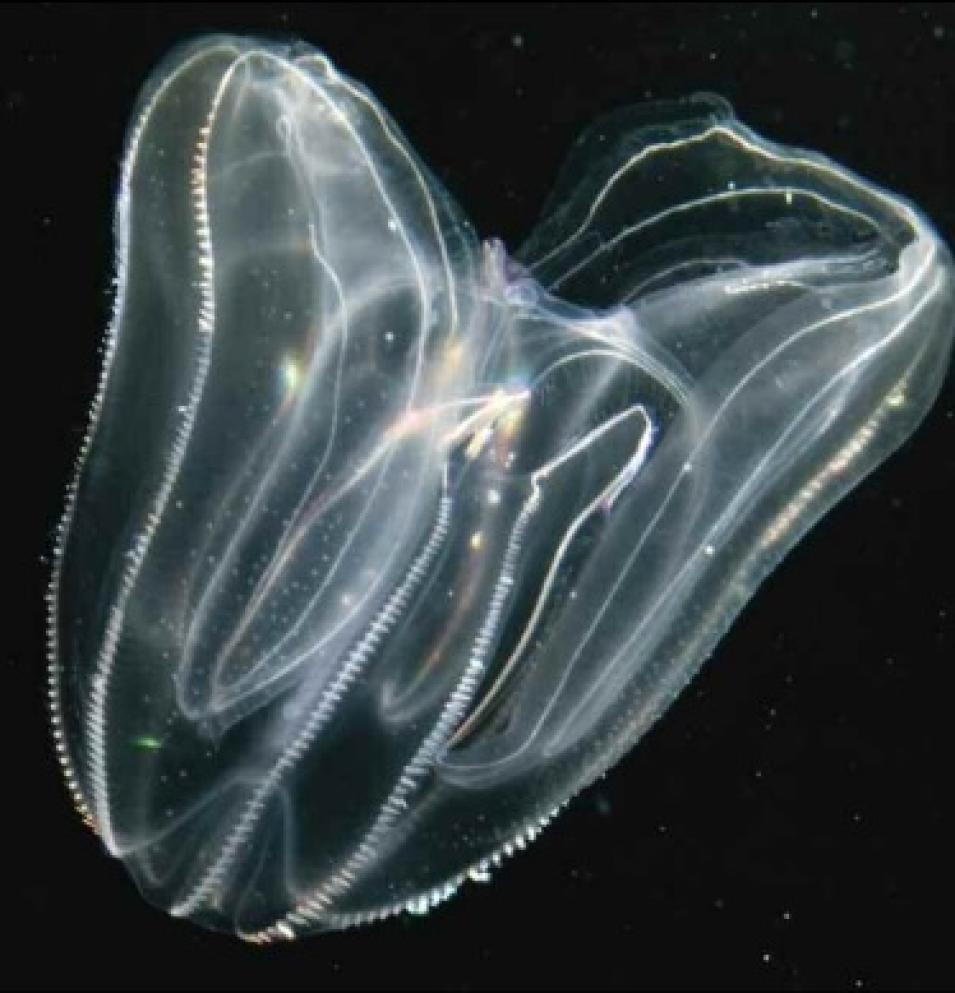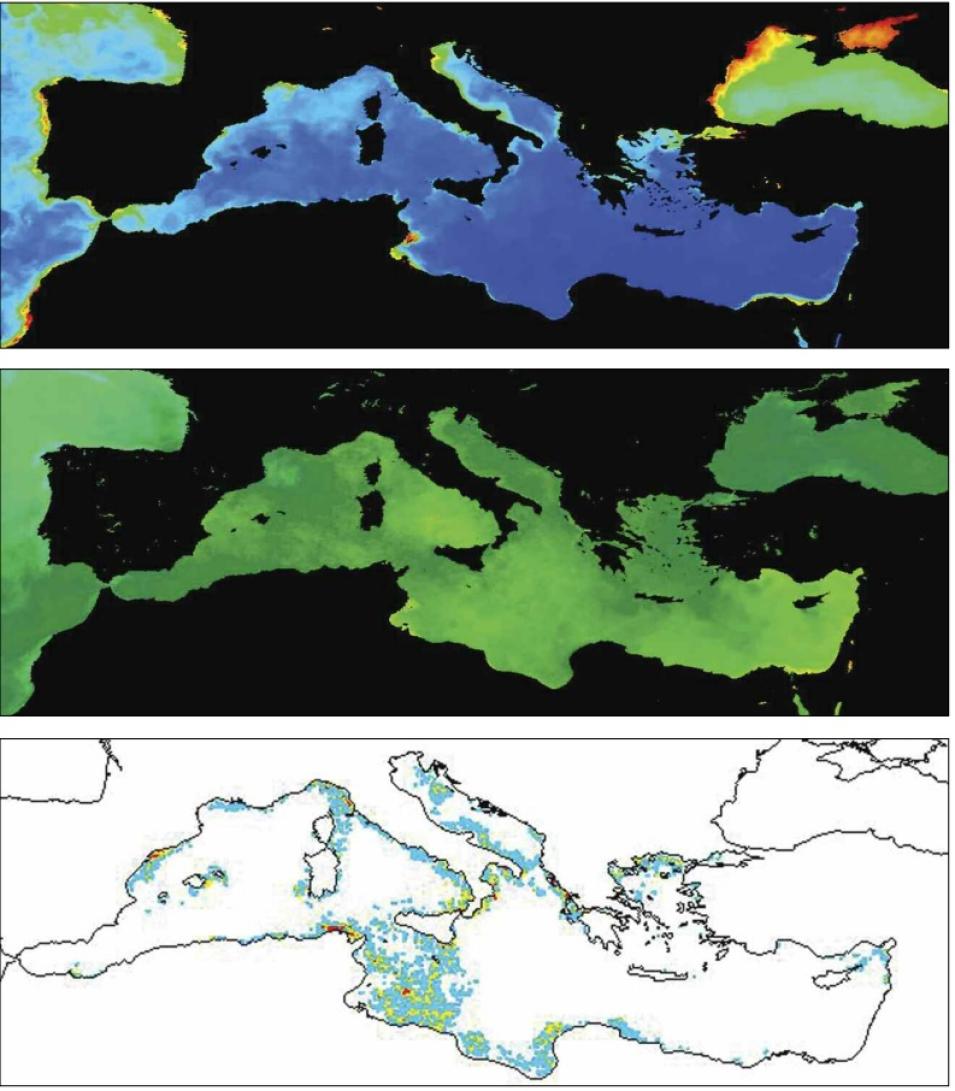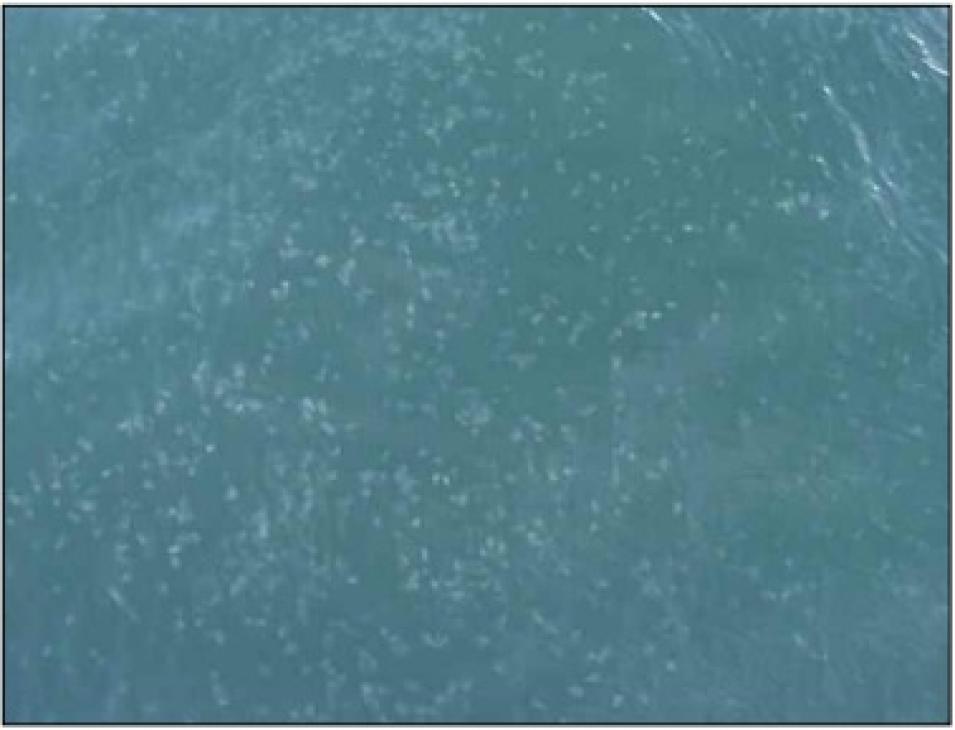The spread of a species
What the researchers really wanted to know was if conditions in the Aegean Sea would allow the comb jelly to multiply and spread, and which regions were most vulnerable. So in addition to ctenophore counts from the plankton sampling stations, they looked at satellite data to learn which environments would best suit the ctenophore. Giannoulaki had done similar work for sardine and anchovy populations. She said, “Sampling data doesn’t tell you about the whole population: it’s just a small piece of information. So we tried to combine this information with the environmental satellite data to get the whole story.”
Giannoulaki used sea surface temperature data from the German Aerospace Agency and from NASA's Moderate Resolution Imaging Spectroradiometer (MODIS) sensor, and photosynthetically active radiation and chlorophyll data from NASA's Ocean Biology Distributed Active Archive Center (OB.DAAC). Together, these data indicate the amount of chlorophyll, which gives an indication of how much food is available in the water.“We combined the satellite data with information about the presence of the species,” Giannoulaki said. “Then we used this information to estimate whether the environmental conditions in an area would be suitable for the species. The aim was to estimate potential areas of the invasive species expansion.”
The researchers then used that model to determine where and when the species was most likely to thrive. Shallow waters, high temperatures, the influx of Black Sea water, which might contain the ctenophore, and high productivity, or food availability, all seemed key for encouraging the growth of ctenophore populations. “Several areas in the western Mediterranean appeared to be good potential habitat for Mnemiopsis,” Giannoulaki said. “We were trying to get the whole story about the spatial distribution of the species. But what you estimate is probabilities—potential habitats. You don’t know if it’s going to be there or not. What you get is whether there are suitable conditions for the species to survive there.”
In their study, published in 2008, Giannoulaki, Siapatis, and their colleagues identified several specific places where the ctenophore was likely to thrive, including parts of the Aegean Sea, the Catalan Sea, and the Adriatic Sea. In 2009, their predictions came true: researchers noticed blooms, or big populations, of the ctenophore off the coasts of Spain and Israel, as well as in the Adriatic. Purcell, who identified the blooms in a recent study, said, “Giannoulaki and Siapatis predicted, in advance of anybody else noticing that the comb jellies were there, that they could be there. I think this study was an excellent example of people using new technologies to creatively look at bigger scale issues.”
An invisible invader
Because so few people study Mnemiopsis, researchers do not know exactly how far or how fast the species is spreading. Many reports of its presence come serendipitously from fishers and people who notice it while studying other animals. Purcell said, “I can say that Mnemiopsis was found near shore in Israel, near shore in Italy, and in the Adriatic last year. But there isn’t actually any information on its real distribution—there are only a few people doing research on these gelatinous animals.” There is little interest in monitoring the species unless it has a major effect on people or the ecosystem, and by then the damage is done. Knowing where the ctenophore is likely to spread could mean that countries might impose rules on ships for filtering their ballast waters, to avoid introducing the species in a place it would likely thrive. But with so little data, some researchers worry that it is only a matter of time before it affects ecosystems and fisheries in other areas. For example, the ctenophore also appeared in the Caspian Sea, chomping on plankton and fish larvae as it had in the Black Sea.
Fortunately, unlike the Caspian and Black Seas, some predators of Mnemiopsis already live in the Mediterranean. That gives researchers some hope. Giannoulaki said, “It’s too soon yet to know where it’s going to distribute. You never know, because the species can tolerate a very wide range of temperatures and salinities, but I hope it will not turn out too badly.
References
Fuentes, V.L., D.L. Angel, K.M. Bayha, D. Atienza, D. Edelist, C. Bordehore, and J.E. Purcell. 2010. Blooms of the invasive ctenophore, Mnemiopsis leidyi, span the Mediterranean Sea in 2009. Hydrogiologia 645: 23-37, doi:10.1007/s10750-010-0205-z.
Mianzan, H.W., P. Martos, J.H. Costello, and R.A. Guerrero. 2010. Avoidance of hydrodynamically mixed environments by Mnemiopsis leidyi (Ctenophora: Lobata) in open-sea populations from Patagonia, Argentina. Hydrobiologia, doi:10.1007/s10750-010-0218-7.
Siapatis, A., M. Giannoulaki, V.D. Valavanis, A. Palialexis, E. Schismenou, A. Machias, and S. Somarakis. 2008. Modelling potential habitat of the invasive ctenophore Mnemiopsis leidyi in Aegean Sea. Hydrobiologia, doi:10.1007/s10750-008-9497-7.
For more information
NASA Ocean Biology Distributed Active Archive Center (OB.DAAC)
NASA Moderate Resolution Imaging Spectroradiometer (MODIS)
Hellenic Centre for Marine Research
| About the remote sensing data used |
|---|
| Satellites | GeoEye OrbView-2 (SeaStar) | Terra |
| Sensors | Sea-Viewing Wide Field-of-View Sensor (SeaWiFS) | Moderate Resolution Imaging Spectroradiometer (MODIS) |
| Data sets | SeaWiFS Level 3 Photosynthetically Active Radiation (PAR) | Chlorophyll a |
| Resolution | 4 kilometers | Milligrams per square meter |
| Parameters | Photosynthetically active radiation | Chlorophyll a concentration |
| DAACs | NASA Ocean Biology Distributed Active Archive Center (OB.DAAC) | NASA OB.DAAC |


